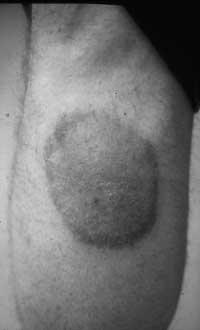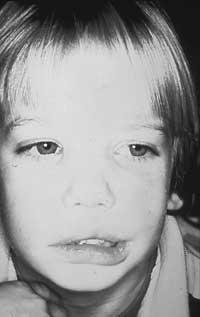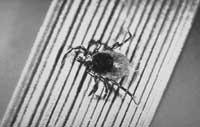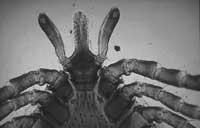LYme disease

Ixodes
However, in Europe XX. The clinical manifestations of this disease were known since the beginning of the 20th century, many years before knowing its causes. In 1909 the Swedish dermatologist Afzelius described the skin lesion called erythema migrans. In 1922 Garin and Bujadoux described the neurological problems associated with erythema migrans. Later, between 1941 and 44, the German Bannwarth saw more neurological changes after skin injury and capers. The neurological anomalies that appeared after the capers' daring were increasingly common and known in the countries of Central and Northern Europe. Thus, such problems became ordinary in countries such as Germany, Switzerland, Austria, Sweden, Finland or France. The discovery of the causal agent in the US showed that it was the same that in Europe generated these problems.
Erythema migrans in Spain was described in 1977 by two dermatologists currently working in the Basque Country (doctors Uruñuela and Díaz). Once the causative agent was known, since 1987, they began to describe patients with this disease in different places of our geography. Dr. García-Moncó's research team, currently at Galdakao Hospital, isolated this bacteria from the chapel first taken in Cantabria.
Interest in this disease has increased in recent years and today is the most common disease contaminated by capers. In fact, several clinical cases have been diagnosed in Euskal Herria.
Symptoms of disease in humans

Lyme disease causes problems in the nervous system, heart, skin, and joints. All symptoms of this disease do not appear in all patients. In the months between May and September the infection is more frequent, especially in the agricultural field and in mountain shifts. Therefore, sinks related to nature (mountain tours, hunting, etc.) and professions (livestock, forestry, beekeeping, etc.) are risk factors for the disease.
The infection, due to its small size and its absence of pain, begins after the daring of the tick that is not perceived. Days later a skin lesion (erythema migrans) characteristic of this disease may appear and associate it with general symptoms such as flu (fever, fatigue, osteomuscular pain, etc. ). ). Erythema is a reddish ringed lesion that rises and clears. Its size ranges from 2 to 50 cm. It is not painful and usually goes away, even without treatment, in one or two months.
Weeks or months later, heart or nerve complications may occur. These are the last in 20th century Europe. Those described since the beginning of the 20th century. Lymphocyte meningitis, fever, headache, improvement of the neck, and vomiting may appear as main symptoms. When a lumbar puncture is performed for the extraction of the cerebrospinal fluid (which permeates the marrow and brain), inflammatory cells (lymphocytes) linked to an increase in proteins can be observed, all as a sign of meninic inflammation. This meningitis may be associated with facial paralysis and limb pain due to inflammation of the nerve roots of these limbs (radiculitis). These clinical manifestations are called Garin-Bujadoux-Bannwarth Syndrome in honor of their discoverers.
When it attacks the heart there is a problem in the transmission of the nerve quinada, the same one that is known with the atrial ventricular block that requires a provisional pacemaker.
Joint inflammation (arthritis) may occur, in some cases chronic, which attacks large joints (knee, ankle) for months or years after the courage of the tick. In addition, they can be chronic neurological problems such as peripheral nerve injury (polyneuropathy) and brain injury (changes in gait and behavior, etc. ). ).
The diagnosis of this disease is based on the history of erythema migrans and the courage of capers associated with the detection of antibodies in the blood of patients.
In order to avoid having to reach late stages with greater difficulty in treatment, it is important to make a diagnosis as soon as possible and establish appropriate treatment. In the initial stages (erythema migrans) antibiotics such as amoxicillin or doxycycline are used and in the later stages monitored antibiotics (penicillin or ceftriaxone).
Lyme Disease at Home

Apart from the cases diagnosed in humans, some animals in species B. Their presence in the bourgeoisie has been confirmed. However, the infection of animals by this borrelia does not necessarily imply the appearance of the disease. Studies of animals with well-established disease have described symptoms similar to those of human disease.
In dogs, for example, anorexia, fever, attenuation, muscle and joint pain, lameness, heat and inflammation of the joints, and in later stages appear arthritis, myocarditis, renal impairment and behavioral changes. In horses, depression of the mind, anorexia and slimming, fever, aches and inflammation of the joints and lame. In cows, in addition to reducing in some cases abortion and milk production, the same symptomatology has been described. In sheep it is only associated with arthritis. At the moment, only the compatible symptoms of Lyme disease in dogs have been described in Spain.
Other published references come from North America and other European countries. In SIMA, when analyzing the blood of some cows disposed with acute anemia and fever, the protozoo of the blood ( Refugia spp. ) a case was detected. In these species, because the symptomatology is not very specific, the diagnosis of this disease is not frequent in the daily work of veterinarians.
Vector material
They are arthropods that feed on the blood of hosts that parasite capers. They are found in the higher parts of the plants to bind them to the skin and feed them of their blood. In a study conducted between 1992 and 1993 on the type of hydalga found in the vegetation of Euskal Herria, Ixodes ricinus, discovered that the pollutant layer of the bacteria responsible for Lyme disease in Europe was one of the most abundant species. The capers are conditioned in sawn vegetation that maintains a high relative humidity, protected against direct sunlight. The largest groups of hidalgos have been found in both wooded and open areas, but with shrub vegetation (ferns, heather and white ote) that generates a microclimate suitable for this species. They remain in force throughout the year, but especially on sunny days of spring and summer months and with animals that have been grazed.

Ixodes ricius, like other species present in the Basque Country, has three stages of development: larva, nymph and maturity. In these phases they must absorb the blood of a host. The adult caparrán lays the eggs in the plants and, when the atmospheric conditions are adequate, larvae with three pairs of legs smaller than 1 mm are born. Larvae usually feed for three or four days from the smallest bushes and then descend to the ground, where they become emerging nymphs. These are slightly larger (2 mm), have four pairs of legs and are usually fed by small bushes, pets or humans. When they are full they fall to the ground and reveal themselves as adults (males or females) and rejoin the big animal and the man. Ticks continue to feed for five or six days and after the fertilization of the males fall into the vegetation and relay the eggs.
The bacteria that produce Lyme disease (Borrelia burgdorferi) is maintained at all stages of capers development. The deposit (in some villages deer and basasagus are considered deposits), that is, the infection of the larvae often occurs when the blood of a passive carrier of the infection is ingested. Ixodes ricinus nymph and adults can more easily spread human disease.
Appearance of Borrelia burgdorferi in the chapels of Euskal Herria
The Department of Health of the Basque Government, in collaboration with the Department of Microbiology of the Carlos III Health Institute of Majadahonda (Madrid), is developing at SIMA a project to learn the appearance of Borrelia in the population of layers of the Basque Country. Capers are collected from vegetation and processed in the laboratory using specific techniques to study whether or not they have Borrelia burgdorferi. Macerated capers, carved in the specific range, are being used to isolate this bacteria. Another technique that is being used is the polymerase chain reaction (PCR), which detects the DNA of the bacteria in the carrier chapel, and we have been able to verify that this technique is fast, specific and more evident. Between 1995 and 1997, samples have been taken in eleven places, of which Borrelia is an isolated or known bourgeoisie in ten affirming its presence in the populations of Ixodes in the Basque Country. Considering the geographical extent of sampling areas, it has been proven that the infection is widespread throughout the community. However, the percentage of infected capers is generally small, although quite different in each aspect. In parallel, studies of pathogenicity with isolated slags and knowledge of possible genospecies are being carried out to determine the predominant variety in the Autonomous Community of the Basque Country. Epidemiological research is complemented by serological research to determine the seroprevalence of infection in the population.
Although several cases have so far been diagnosed in the Basque Country, as it is a newly diagnosed disease in the United States and Europe, it seems that this disease is not taken into account when making a differential diagnosis with other diseases of comparable symptomatology. In addition, the biggest drawback is that patients rarely associate the courage of the tick with symptoms that may appear weeks later.
Disease prevention
In those who by their professions or hobbies have to do with nature, the risk of chance is greater. In this way, families who spend the day in pastoralists, farmers, foresters, mushroom pickers, mountaineers and mountain recreation areas are more at risk of being victims of the capers' daring, so be careful.

To avoid daring it is convenient to use long pants or high socks, although capers can come up from clothing and stick on the skin. Therefore, after an excursion to the mountain, if the place in which we have moved has the aforementioned characteristics, the most direct measure is the tracking of the skin and clothing in search of capers. According to published studies, the layer should be associated with the skin between 24 and 48 hours to infect the disease, so the importance of removing it as soon as possible. The longer you have been feeding the tick, the more risk you have of getting sick.
The best way to remove a tick is to keep it as close as possible to the skin with a clamp and attract it sustainably in the same direction, trying to remove it completely, without leaving inside its mouth (hypostoma) that introduces it into the skin. The popular customs of removing capers, soaking them with alcohol, oil, gasoline or other substance, or burning them with cigarettes are not recommended, since in response, the capers can inject their victim the intestinal content in which the bacteria are found, facilitating the contamination of the disease.
Tick control
Among the measures to control the abundance of capers in the agricultural sector, the simplest and easiest to carry out is the application of antiparasitic treatments to pets. For example, garrangas, shampoos, powders or topical solutions for dogs. For livestock animals, in times of higher risk of infection, the dose of insecticide bath, spray or product is distributed through the “pour-on” system that is applied directly in the spine. These treatments prevent animals from being parasitized and also increase the difficulty of finding a host in feeding capers, cutting the capers cycle.
On the other hand, you can fight in risk areas using insecticides directly in the vegetation. In the use of an insecticide we must take into account the negative effect that can occur on the environment, since it not only acts against capers, but on all the terrestrial fauna and, in addition, some of the products sold are very sustainable in the environment. This way of fighting is only recommended in those areas of risk where in addition to the infection there are large populations of capers Ixodes ricinus.
Another effective path is the habitat modification of capers, that is, the regular mechanical felling of shrub vegetation in problem areas. Other routes that are cited are controlled burning or herbicide treatments, since when changing the microclimate the capers are exposed, both in the winter cold and in the sun of the warm months.
Buletina
Bidali zure helbide elektronikoa eta jaso asteroko buletina zure sarrera-ontzian











